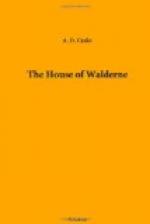Behind, the ground rose gradually to the summit of the ridge—which formed a sort of backbone to the Andredsweald. The ridge was then, as now, surmounted by a windmill, belonging then to the lords of the castle, where all his tenants and retainers were compelled to grind their corn. It commanded a beautiful view of sea and land; a hostelry stood near the summit, it was called the Cross in Hand, for it was once the rendezvous of the would-be crusaders, who, from various parts of the Weald, took the sacred badge, and started for the distant East via Winchelsea or Pevensey.
In the deep dark wood were many settlements and clearings; Walderne was perhaps the wildest, as its name implies; around lay Chiddinglye, once the abode of the Saxon offspring of Chad or Chid; Hellinglye (Ella-inga-leah), the home of the sons of Ella, of whom we have written before; Heathfield and Framfield on opposite sides, open heaths in the wood, covered with heather and sparsely peopled; Mayfield to the north, once the abode of the great Saint Dunstan, and the scene of his conflicts with Satan; Hothly to the south, where, at the date of our tale, lived the Hodleghs, an Anglo-Norman brood.
The Lord of Walderne was Ralph, son of Sybilla de Dene (West Dean) and Robert of Icklesham (near Winchelsea). He was blessed, or cursed, as the case might be, with three children; Roger, Sybil, and Mabel.
The old man came of a stern fighting stock: what wonder that his son inherited his character in this respect. He was a wilful yet affectionate lad of strong passions, one who might be led but never driven: unfortunately his father did not read his character aright, and at length a crisis arose.
Roger wooed the daughter of the neighbouring Lord of Hothly, but found a rival in a cousin, one Waleran de Dene, a favourite of his father, and a constant visitor at Walderne Castle. In those rude days the solution of the difficulty seemed simple—to fight the question out. The dead man would trouble neither lad nor lass any more, the living lead the fair bride to church; and, sooth to say, there were many misguided maidens who were proud to be fought for, and quite willing to give their hand to the victor.
So Roger challenged his cousin to fight when he met him returning from a visit to Edith de Hodlegh, and the challenge being readily accepted, the unhappy Waleran de Dene bit the dust. The old lord, grieving sore over the death of his sister’s son, drove Roger from home and bade him never darken his doors again, till he had made reparation by a pilgrimage or a crusade; and Roger departed, mourned by his sisters and all the household, and was heard of no more during his father’s lifetime.
But more grief was in store for the stern old lord of Walderne. The third child, Mabel, the youngest daughter, fell in love with a handsome young hunter, a Saxon outlaw of the type of Robin Hood, who delivered her from a wild boar which would have slain or cruelly mangled her. The old father had inspired no confidence in his children: she met her outlaw again and again by stealth, and eventually became the bride of Wulfstan, last representative of the old English family who had possessed Michelham before the Conquest {3}.




